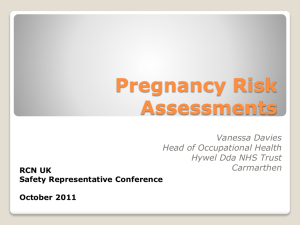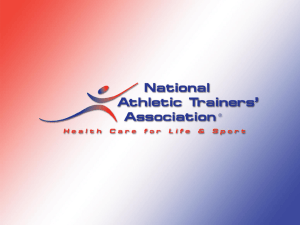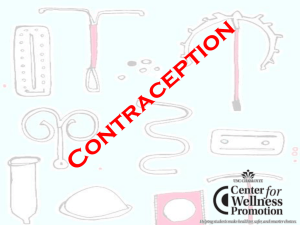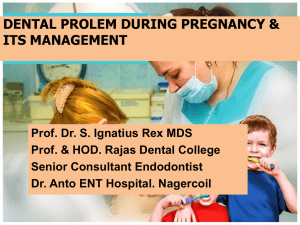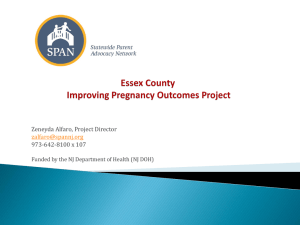Guidance on Hazards in a Clinical Environment
advertisement
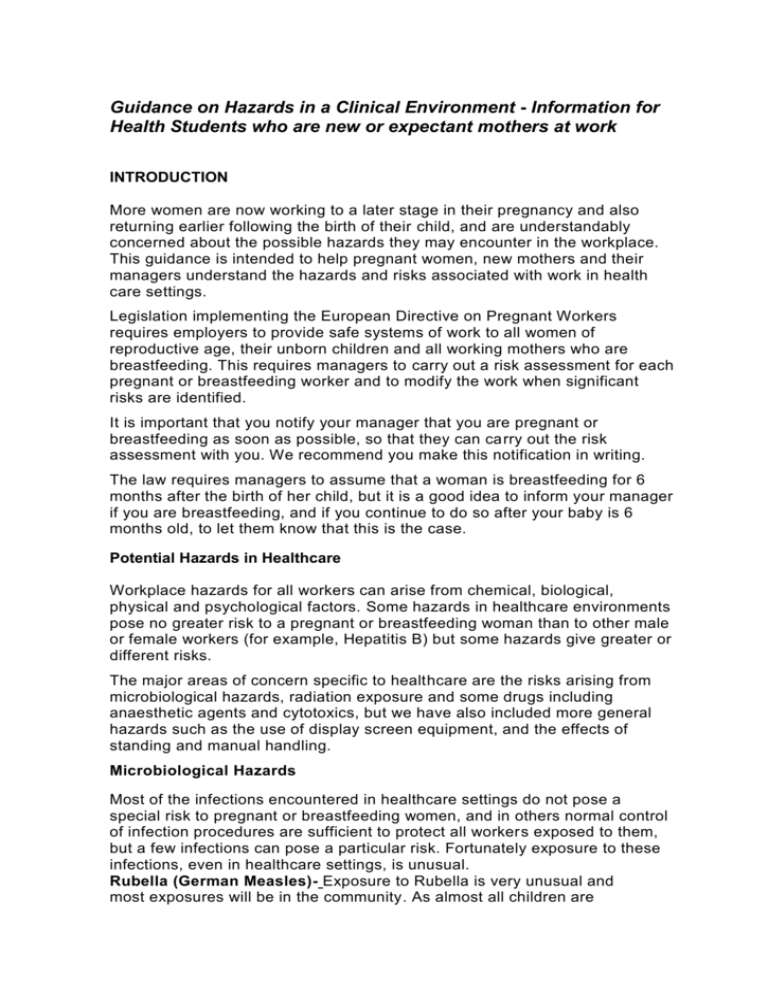
Guidance on Hazards in a Clinical Environment - Information for Health Students who are new or expectant mothers at work INTRODUCTION More women are now working to a later stage in their pregnancy and also returning earlier following the birth of their child, and are understandably concerned about the possible hazards they may encounter in the workplace. This guidance is intended to help pregnant women, new mothers and their managers understand the hazards and risks associated with work in health care settings. Legislation implementing the European Directive on Pregnant Workers requires employers to provide safe systems of work to all women of reproductive age, their unborn children and all working mothers who are breastfeeding. This requires managers to carry out a risk assessment for each pregnant or breastfeeding worker and to modify the work when significant risks are identified. It is important that you notify your manager that you are pregnant or breastfeeding as soon as possible, so that they can carry out the risk assessment with you. We recommend you make this notification in writing. The law requires managers to assume that a woman is breastfeeding for 6 months after the birth of her child, but it is a good idea to inform your manager if you are breastfeeding, and if you continue to do so after your baby is 6 months old, to let them know that this is the case. Potential Hazards in Healthcare Workplace hazards for all workers can arise from chemical, biological, physical and psychological factors. Some hazards in healthcare environments pose no greater risk to a pregnant or breastfeeding woman than to other male or female workers (for example, Hepatitis B) but some hazards give greater or different risks. The major areas of concern specific to healthcare are the risks arising from microbiological hazards, radiation exposure and some drugs including anaesthetic agents and cytotoxics, but we have also included more general hazards such as the use of display screen equipment, and the effects of standing and manual handling. Microbiological Hazards Most of the infections encountered in healthcare settings do not pose a special risk to pregnant or breastfeeding women, and in others normal control of infection procedures are sufficient to protect all workers exposed to them, but a few infections can pose a particular risk. Fortunately exposure to these infections, even in healthcare settings, is unusual. Rubella (German Measles)- Exposure to Rubella is very unusual and most exposures will be in the community. As almost all children are immunised against Rubella through the MMR and Faculty immunisation programmes, and all women are routinely tested in pregnancy, exposure in the community is also rare. If you are at risk of Rubella infection during your pregnancy, you will be told, and offered immunisation after your baby is born to protect you in subsequent pregnancies. However, as all healthcare workers are tested for Rubella immunity and immunised where appropriate when they start in the NHS, you should know that you are immune. Evidence has shown that acquiring Rubella in the first 12 weeks of pregnancy carries 90% risk of congenital abnormalities eg hearing defects. The foetus is still at risk even near term although defects at this stage appear small. Cytomegalovirus (CMV) - This is a very common infection in children. Most infections are symptomless but it can cause an illness similar to glandular fever. Serious illness is usually only found in those with other medical conditions which have resulted in seriously impaired immune systems. About 50% of people in the Sheffield area are already immune by the time they are 40. Most infections occur in the community. Infection is spread by exposure to infected saliva or urine, or by sexual contact with an infectious person. No vaccine is available. CMV has been shown to cause abnormalities in a minority of babies exposed to the infection before the birth, but there is no evidence of a significantly increased risk of congenital abnormality in the offsprin g of staff working with infants, children or in the hospital environment. Hence, there is no need to restrict the employment of pregnant women in nurseries or hospital units dealing with infants and children. Normal hygiene practices - hand=washing and avoidance of direct contact with saliva or urine (including wet nappies), by the use of gloves and aprons, should be sufficient to prevent spread from a person known to be infectious. Hepatitis B - All health care workers who are likely to be at risk of Hepatitis B infection by blood exposure in the course of their work are immunised routinely. There is no increased risk of infection to pregnant women. You should continue to follow universal precautions, using protective equipment where required. If you do have a blood exposure, you should report it quickly to the Occupational Health service in the normal way. Hepatitis B virus does not cross the placenta so even if you are infected in pregnancy, your baby would not be infected, however, there is a risk of transmission to the baby during delivery. Human Immunodeficiency Virus (HIV) and Hepatitis C Virus (CCV) Health care workers may be exposed to HIV/HCV if they have a blood exposure from a HIV/HCV positive patient. The incidence of HIV in the general Sheffield population is low. Hepatitis C is relatively common among injecting drug addicts but not common in the general population in Sheffield, so the risk of infection from either these viruses from blood exposure is low. Pregnant women are not at increased risk, but there is a possibility that the baby could be infected in childbirth if the mother is infected. As there is no vaccine for these viral infections, all health care workers must observe universal precautions and report blood exposure incidents to Occupational Health promptly. Treatment (post exposure prophylaxis) is available for HIV exposure, but the drugs used are modified for pregnant women. Varicella Zoster (Chicken Pox and Shingles) - Chicken Pox in pregnancy can be a serious disease, and may result in brain damage, limb abnormalities and skin scarring in the unborn child. Most women are immune to chicken pox as they have had they disease in childhood. If you do not know if you are immune, you should not work with patients with chicken pox or shingles, and if you are exposed outside work, you should inform your GP, antenatal clinic or midwife and Occupational Health quickly. Toxoplasma - Toxoplasma is usually acquired by hand to mouth contact with faeces of cats, eating undercooked meats, contaminated soil and poorly washed garden vegetables, so you should wear gloves and wash your hands thoroughly if handling soil, garden vegetables of faeces. Patients with Toxoplasmosis do not pose a risk to healthcare workers because person-to-person transmission does not occur, but infection with the disease in pregnancy can cause eye and brain damage. Vertical transmission to the foetus can occur if the mother is infected in pregnancy, but person-to-person transmission does not occur, so occupational transmission will not occur. Listeria - This is a form of food poisoning, which poses a risk to pregnant women in particular because infection in pregnancy may cause miscarriage or perinatal infection. The risk of occupational exposure only arises for health care workers working with patients infected with Listeria. It would be sensible for pregnant staff not to work with a patient known to have Listeria, even though good hygiene practice and barrier nursing would protect them. Catering workers should observe normal precautions for handling food which has been accociated with Listeria transmission (soft cheese, paté and coleslaw) and ensure they wash their hands before eating. Parvovirus B19 (slapped cheek syndrome or fifth disease) - This causes a mild illness with a rash similar to rubella and is thought to spread by the respiratory route. It commonly circulates among primary Faculty children and occupational exposure is rare outside specialised units such as haematology and childcare settings. The incubation period is usually from 13-18 days but can be up to 21 days. At least 25% of infections are asymptomatic. Immunity after recovery from infection is lifelong. There is no risk to humans from canine parvovirus - the virus is quite different. Health care workers who are in the first 20 weeks of pregnancy should not work with patients with acute parvovirus infection, because about 40% of women of childbearing age lack antibodies to parvovirus B19 and are therefore susceptible to infection, which can lean to an increased risk of miscarriage and foetal hydrops (anaemia and congestive heart infection in the unborn baby). The increased risk of miscarriage is 9% for an infection of the mother occurring during the first 20 weeks of pregnancy. Unborn babies who recover from foetal hydrops suffer no long-term damage. For mothers who are beyond 20 weeks pregnancy there is no increased risk of miscarriage. Methicillin Resistant Staphylococcus Aureas (MRSA) - MRSA does not pose an increased risk in pregnancy or to breastfeeding women. Physical Hazards Ionising Radiation (X-rays and other radioactive sources) - Most staff working in hospitals are not exposed to significant levels of radiation and the use of ionising radiations in the Sheffield Teaching Hospitals NHS Trust is closely controlled by legal requirements. All members of staff working with ionising radiation receive appropriate training and are subject to Systems of work, as described in the Local Rules, to minimise risk of exposure. As a result, few staff are likely to approach the suggested dose limit in pregnancy. If you are in a job where you regularly work with ionising radiation (ie are routinely monitored with a film badge) you are encouraged to declare your pregnancy early, so the pattern of work can be altered if necessary. You should inform your manager and the dosimetry service. Any specific additional safety requirements for pregnant staff, beyond those required for routine practice will usually be listed in the appropriate Local Rules. In the unusual situation that there is a source of ionising radiation on the wards, the most common circumstances and their methods of control will be described in the Local Rules or supplementary nuclear medicine patient information sheet. Follow the instructions of the radiographer/physicist/technician or contact your radiation protection advisor if you need any further advice. For departments and wards that occasionally receive radioactive patients following nuclear medicine procedures, written advice is provided for each patient will include the necessary precautions. There is no risk of exposure to ionising radiation from portable x-ray machines in normal practice, if you are more than 2 metres away from the patient of the machine. The radiographer operating the x-ray machine will also ensure that appropriate measures have been taken for staff to vacate the area. Display Screen Equipment - There is no evidence that harmful radiation is emitted from computers and display screen equipment so the use of this equipment in pregnancy is not hazardous. If you still have concerns please contact Occupational Health for advise and reassurance. The need for comfort and a proper workstation set-up are important, you may need to be adjusted as your pregnancy advances, so your workstation assessment may need to be reviewed. Manual Handling - Pregnant workers are especially at risk from manual handling injury particularly as hormonal changes can affect the ligaments, increasing susceptibility to injury, and postural problems may increase as the pregnancy progresses. These risks are minimised by the Trust's manual handling policies and the use of safe working practices, but your manager will probably need to check the risk assessment and your working practices if your job involves manual handling or lifting. Fatigue - Fatigue from standing and other physical work has long been associated with miscarriage, premature birth and low birth weight. Hence, excessive hours should not be worked and seating should be available whenever possible. Rest breaks are important and should be taken. Employers are required to make suitable provision for employees to rest. Excessive temperatures - Pregnant women may be more sensitive to high temperatures, and may be more likely to faint. Breast feeding may be impaired by heat dehydration, so it is important that you drink plenty of water. Adequate rest periods and facilities should be provided. Cold environment - No specific problems normally arise from working in cold environments. Shift Work - If you have to work nights and you have a medical certificate from your GP to state that night work could affect your health and safety from a risk arising at your work, suitable daytime work must be offered if possible. Health and Safety issues arising from night work, if relevant, will form part of the individual risk assessment your manager will carry out. Stress and anxiety - Foetal development may be adversely affected by stress, which may be due to excess physical or mental pressures. Stress may also cause a rise in blood pressure and anxiety and fatigue may also contribute. Women at work may find it stressful that they have a dual role in society, domestic pressures at home as well as work pressures. It is important you identify any stress and pressure you may be under. your manager will need to work with you to identify any work related pressures, and to seek solutions for these; attention may need to be paid to your hours of work, the pace and volume of your work and how much control you have over it. Chemical Hazards Safe working practices are necessary at all times when using any potentially hazardous substance at work and the risk assessment process required under the COSHH regulations requires risks to pregnant workers to be assessed and controlled routinely. You should be aware of chemicals you work with and the necessary precautions and safe working practices. Anaesthetic Gases- Anaesthetic gases must be monitored and controlled in your area under the Control of Substances Hazardous to Health (COSHH) Regulations 1999. Research has been contradictory over the past few years, with older studies showing that exposure to anaesthetic gases has been linked to miscarriage, premature birth and congenital abnormalities, but more recent studies have failed to show similar effects, probably due to changes in anaesthetic techniques which have reduced exposure. It is advisable to seek advice from your manager if you have concerns. Cytotoxic drugs- These drugs may cause damage to genetic information in reproductive cells, but the effect on pregnancy in those who handle them occupationally is unclear. The major risk of exposure arises where these drugs are being reconstituted and prepared for use, which must be done under strict controls. All staff on wards and in departments who administer and reconstitute these drugs, should be aware of the local and departmental policies, risk assessments that have been carried out and precautions that have been put in place. Mercury- It may be necessary for dentists and their assistants to handle mercury as part of their work, but there is no evidence that inorganic mercury causes adverse effects in pregnancy or to new mothers. Formaldehyde, Gluteraldehyde and Xylene- There is no evidence to suggest that formaldehyde or gluteraldehyde affects the foetus. Their use should be monitored under the COSHH Regulations and all precautions must be observed. Studies of Xylene have shown no link to problems in pregnancy. We hope this information has helped you to understand the potential risks, which may arise in the workplace for expectant and new mothers. Health Professions have a large predominantly female workforce, and so many health care workers combine motherhood and working, with very few problems related to work. We wish you the best of health during your pregnancy. If you have any further queries please contact the Course Leader or the Professional Issues Team (Marie Hollingworth) Faculty of Health and Wellbeing, Collegiate Campus, on telephone number 0114 2255934. June 2003


